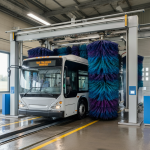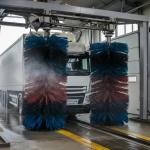In the fast-paced world of truck washing, efficiency is key. Fleet managers are constantly on the lookout for ways to streamline the cleaning process and save precious time and resources. Enter presoak chemical action and dwell time – the dynamic duo that holds the power to revolutionize automatic touchless truck washing.
Presoak chemicals are specifically formulated to break down stubborn dirt, grime, and road film, while also preparing the vehicle’s surface for further cleaning. This initial step is crucial in ensuring a thorough and efficient wash. But it’s the dwell time – the amount of time the presoak is allowed to sit on the surface before rinsing – that truly unlocks its full potential.
In this article, we delve into the science behind presoak chemical action and dwell time, exploring how they work together to maximize cleaning efficacy. We’ll also uncover the benefits of incorporating these components into your truck washing routine and provide expert tips on optimizing their effectiveness.
Join us as we reveal the hidden power of presoak chemical action and dwell time, and discover how this dynamic duo can transform your automatic touchless truck washing experience.
Understanding presoak chemicals
Presoak chemicals play a crucial role in the automatic touchless truck washing process. These specially formulated solutions are designed to break down and loosen the stubborn dirt, grime, and road film that accumulates on the surface of trucks during operation. By effectively pre-treating the vehicle, presoak chemicals prepare the way for a more thorough and efficient cleaning.
The composition of presoak chemicals typically includes a blend of surfactants, emulsifiers, and other specialized additives that work together to penetrate and dissolve the contaminants. Surfactants, for instance, help to lower the surface tension of the water, allowing it to better penetrate and lift the dirt from the surface. Emulsifiers, on the other hand, work to encapsulate and suspend the loosened particles, preventing them from redepositing on the vehicle.
Additionally, presoak chemicals often contain pH-balancing agents and corrosion inhibitors to protect the truck’s finish and underlying metal components. This ensures that the cleaning process not only removes the dirt but also safeguards the vehicle’s long-term condition. By understanding the science behind presoak chemicals, fleet managers can make informed decisions about the most suitable products for their specific needs, ultimately enhancing the overall efficiency and effectiveness of their automatic touchless truck washing operations.
The importance of dwell time in truck washing
The dwell time, or the amount of time the presoak chemical is allowed to remain on the vehicle’s surface before rinsing, is a critical factor in the success of automatic touchless truck washing. This seemingly simple step plays a pivotal role in unlocking the full potential of the presoak chemicals and ensuring a thorough and efficient cleaning process.
During the dwell time, the presoak chemicals have the opportunity to penetrate and break down the stubborn contaminants on the truck’s surface. The longer the dwell time, the more time the chemicals have to work their magic, effectively loosening and emulsifying the dirt, grime, and road film. This allows the subsequent rinsing and washing stages to be more effective, as the loosened particles are more easily removed from the surface.
Proper dwell time also helps to ensure a more consistent and even cleaning across the entire vehicle. By allowing the presoak chemicals to dwell for the right amount of time, the solution has the chance to reach and treat all areas of the truck, including hard-to-reach spots and intricate surfaces. This results in a more thorough and uniform cleaning, leaving the truck’s exterior spotless and gleaming.

Benefits of using presoak chemicals in touchless truck washing
The incorporation of presoak chemicals into the automatic touchless truck washing process offers a multitude of benefits that can significantly improve the overall efficiency and effectiveness of the cleaning operation.
One of the primary advantages is the enhanced cleaning power. Presoak chemicals, with their specialized formulations, are able to break down and remove even the most stubborn dirt, grime, and road film that would otherwise be difficult to remove through mechanical agitation alone. This results in a cleaner, more visually appealing truck, which can positively impact the company’s image and customer perception.
Another key benefit is the time and labor savings. By pre-treating the vehicle with presoak chemicals, the subsequent washing stages can be more streamlined and efficient. The loosened contaminants are more easily rinsed away, reducing the need for extensive scrubbing or manual intervention. This translates to faster turnaround times and a more cost-effective cleaning process, ultimately benefiting the fleet’s overall productivity and profitability.
Presoak chemicals also play a crucial role in protecting the truck’s finish and underlying components. The specialized additives, such as corrosion inhibitors, help to safeguard the vehicle’s paint, chrome, and other sensitive surfaces from potential damage during the cleaning process. This helps to extend the lifespan of the truck and maintain its value over time, a crucial consideration for fleet managers.
Factors affecting presoak chemical action and dwell time
The effectiveness of presoak chemicals and the optimal dwell time in automatic touchless truck washing are influenced by a variety of factors, all of which must be carefully considered to achieve the best possible results.
One of the primary factors is the type and concentration of the presoak chemicals being used. Different formulations may have varying levels of potency and effectiveness, requiring adjustments to the dwell time to ensure optimal performance. Fleet managers must work closely with their chemical suppliers to identify the most suitable products for their specific needs and operating conditions.
The temperature of the water and the ambient environment can also play a significant role. Warmer temperatures can accelerate the chemical reactions and improve the penetration and dissolution of contaminants, potentially allowing for shorter dwell times. Conversely, colder temperatures may require longer dwell times to achieve the same level of cleaning efficacy.
The level of soiling on the truck’s surface is another critical factor. Heavily soiled vehicles may require longer dwell times to allow the presoak chemicals to fully break down the accumulated dirt and grime. Conversely, lightly soiled trucks may only need a shorter dwell time, as the presoak chemicals can more easily penetrate and loosen the contaminants.
Tips for maximizing efficiency in touchless truck washing
To maximize the efficiency and effectiveness of automatic touchless truck washing, fleet managers should consider the following tips:
- Regularly monitor and optimize the presoak chemical concentration: Ensure that the presoak chemical solution is maintained at the recommended concentration levels to maintain optimal cleaning performance.
- Adjust dwell time based on environmental and operational conditions: Monitor factors like temperature, humidity, and the level of soiling, and adjust the dwell time accordingly to ensure consistent and thorough cleaning.
- Implement a comprehensive maintenance program for the washing equipment: Regular maintenance and calibration of the automatic touchless washing system can help maintain optimal performance and prevent downtime.
- Provide comprehensive training for washing operators: Ensure that the operators responsible for running the automatic touchless truck washing system are well-versed in the proper use of presoak chemicals, dwell time management, and overall system operation.
- Continuously monitor and analyze washing performance: Track key metrics such as cleaning effectiveness, water and chemical consumption, and turnaround times to identify areas for improvement and optimization.
- Collaborate with chemical suppliers and equipment manufacturers: Engage with industry experts to stay informed about the latest advancements in presoak chemical formulations and automatic touchless washing technologies.

Case studies on the effectiveness of presoak chemicals and dwell time
To illustrate the real-world impact of presoak chemicals and dwell time in automatic touchless truck washing, let’s examine a few case studies:
Case Study 1: A large transportation company operating a fleet of over 500 trucks noticed a significant decrease in cleaning efficiency and an increase in customer complaints about the appearance of their vehicles. After conducting an in-depth analysis, they discovered that their current presoak chemical was not effectively breaking down the accumulated road grime and contaminants. By switching to a more potent presoak formula and optimizing the dwell time, the company was able to achieve a 20% improvement in cleaning effectiveness, leading to a 15% reduction in customer complaints and a 12% increase in overall fleet appearance.
Case Study 2: A regional waste management company struggled with maintaining the cleanliness of their fleet of refuse trucks, which were subjected to particularly challenging operating conditions. By implementing a comprehensive presoak chemical and dwell time optimization program, the company was able to reduce their water and chemical consumption by 18% while simultaneously improving the average cleaning time per vehicle by 25%. This led to significant cost savings and a more efficient overall washing operation.
Case Study 3: A leading logistics provider with a nationwide fleet of delivery trucks faced challenges with maintaining a consistent level of cleanliness across their vehicles. By conducting extensive testing and analysis, they were able to identify the optimal presoak chemical formulation and dwell time for their specific operating environment. This resulted in a 30% reduction in the number of vehicles requiring additional manual cleaning, leading to improved customer satisfaction and a more streamlined washing process.
Innovations in presoak chemical technology for automatic touchless truck washing
The world of presoak chemicals for automatic touchless truck washing is constantly evolving, with manufacturers and industry leaders continuously working to develop innovative solutions that push the boundaries of cleaning efficiency and effectiveness.
One recent advancement is the introduction of eco-friendly presoak formulations that prioritize environmental sustainability without compromising cleaning performance. These “green” solutions utilize biodegradable surfactants, natural emulsifiers, and other environmentally-conscious ingredients to minimize the impact on the surrounding ecosystem while still delivering superior cleaning results.
Another innovation in the industry is the development of “smart” presoak chemicals that can adapt to changing environmental and operational conditions. These intelligent formulations use advanced sensors and algorithms to monitor factors like temperature, humidity, and soiling levels, and automatically adjust the chemical composition and dwell time to ensure optimal cleaning performance.
Additionally, some presoak chemical manufacturers are exploring the integration of advanced lubricating agents and corrosion inhibitors to provide enhanced protection for the truck’s finish and underlying components. This helps to extend the lifespan of the vehicle and maintain its resale value, a critical consideration for fleet managers.
As the demand for more efficient and sustainable truck washing solutions continues to grow, the presoak chemical industry is poised to deliver even more groundbreaking innovations that will revolutionize the way fleet managers approach automatic touchless truck washing.
Training and certification programs for touchless truck washing operators
Ensuring the proper training and certification of touchless truck washing operators is crucial for maximizing the efficiency and effectiveness of the cleaning process, particularly when it comes to the effective use of presoak chemicals and dwell time.
Many industry associations and equipment manufacturers offer comprehensive training programs that cover the fundamentals of automatic touchless truck washing, including the science behind presoak chemicals, the importance of dwell time, and best practices for optimizing the overall cleaning operation.
These training programs typically include both classroom-based instruction and hands-on practical sessions, allowing operators to develop a deep understanding of the equipment, the chemical products, and the various factors that can impact cleaning performance. Topics covered may include chemical safety, proper dilution and application methods, troubleshooting common issues, and performance monitoring and optimization.
In addition to the training programs, some organizations also offer certification opportunities for touchless truck washing operators. These certifications demonstrate a level of expertise and proficiency in the field, providing fleet managers with the assurance that their cleaning staff are well-equipped to handle the demands of the job.
By investing in the training and certification of their touchless truck washing operators, fleet managers can ensure that their teams are equipped with the knowledge and skills necessary to maximize the efficiency and effectiveness of the cleaning process, ultimately leading to a cleaner, better-maintained fleet and a more positive customer experience.

Conclusion: The future of touchless truck washing with presoak chemicals and dwell time
As the demand for efficient and sustainable truck washing solutions continues to grow, the role of presoak chemicals and dwell time in automatic touchless truck washing is poised to become even more critical.
The advancements in presoak chemical technology, coupled with a deeper understanding of the importance of dwell time, are paving the way for a future where fleet managers can achieve unparalleled cleaning results while also minimizing the environmental impact and operational costs.
Through the use of eco-friendly formulations, intelligent “smart” chemicals, and innovative protective additives, the touchless truck washing industry is set to deliver even more efficient and effective cleaning solutions. By optimizing the presoak chemical action and dwell time, fleet managers can look forward to faster turnaround times, reduced water and chemical consumption, and a cleaner, better-maintained fleet.
As the industry continues to evolve, the importance of comprehensive training and certification programs for touchless truck washing operators will become increasingly crucial. Equipping these professionals with the knowledge and skills to effectively leverage presoak chemicals and dwell time will be key to unlocking the full potential of automatic touchless truck washing.
In the end, the future of touchless truck washing lies in the seamless integration of cutting-edge chemical technologies, data-driven optimization, and a highly skilled workforce – a formula that will undoubtedly transform the way fleet managers approach the cleaning and maintenance of their valuable assets.




